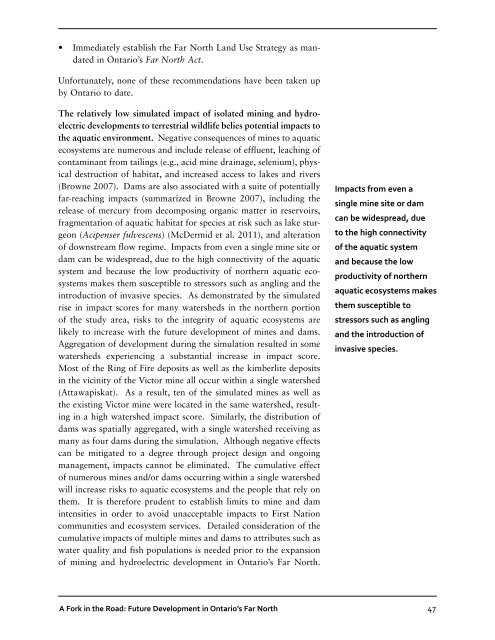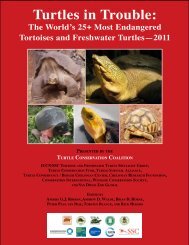You also want an ePaper? Increase the reach of your titles
YUMPU automatically turns print PDFs into web optimized ePapers that Google loves.
• Immediately establish the Far North Land Use Strategy as mandated<br />
in Ontario’s Far North Act.<br />
Unfortunately, none of these recommendations have been taken up<br />
by Ontario to date.<br />
The relatively low simulated impact of isolated mining and hydroelectric<br />
developments to terrestrial wildlife belies potential impacts to<br />
the aquatic environment. Negative consequences of mines to aquatic<br />
ecosystems are numerous and include release of effluent, leaching of<br />
contaminant from tailings (e.g., acid mine drainage, selenium), physical<br />
destruction of habitat, and increased access to lakes and rivers<br />
(Browne 2007). Dams are also associated with a suite of potentially<br />
far-reaching impacts (summarized in Browne 2007), including the<br />
release of mercury from decomposing organic matter in reservoirs,<br />
fragmentation of aquatic habitat for species at risk such as lake sturgeon<br />
(Acipenser fulvescens) (McDermid et al. 2011), and alteration<br />
of downstream flow regime. Impacts from even a single mine site or<br />
dam can be widespread, due to the high connectivity of the aquatic<br />
system and because the low productivity of northern aquatic ecosystems<br />
makes them susceptible to stressors such as angling and the<br />
introduction of invasive species. As demonstrated by the simulated<br />
rise in impact scores for many watersheds in the northern portion<br />
of the study area, risks to the integrity of aquatic ecosystems are<br />
likely to increase with the future development of mines and dams.<br />
Aggregation of development during the simulation resulted in some<br />
watersheds experiencing a substantial increase in impact score.<br />
Most of the Ring of Fire deposits as well as the kimberlite deposits<br />
in the vicinity of the Victor mine all occur within a single watershed<br />
(Attawapiskat). As a result, ten of the simulated mines as well as<br />
the existing Victor mine were located in the same watershed, resulting<br />
in a high watershed impact score. Similarly, the distribution of<br />
dams was spatially aggregated, with a single watershed receiving as<br />
many as four dams during the simulation. Although negative effects<br />
can be mitigated to a degree through project design and ongoing<br />
management, impacts cannot be eliminated. The cumulative effect<br />
of numerous mines and/or dams occurring within a single watershed<br />
will increase risks to aquatic ecosystems and the people that rely on<br />
them. It is therefore prudent to establish limits to mine and dam<br />
intensities in order to avoid unacceptable impacts to First Nation<br />
communities and ecosystem services. Detailed consideration of the<br />
cumulative impacts of multiple mines and dams to attributes such as<br />
water quality and fish populations is needed prior to the expansion<br />
of mining and hydroelectric development in Ontario’s Far North.<br />
Impacts from even a<br />
single mine site or dam<br />
can be widespread, due<br />
to the high connectivity<br />
of the aquatic system<br />
and because the low<br />
productivity of northern<br />
aquatic ecosystems makes<br />
them susceptible to<br />
stressors such as angling<br />
and the introduction of<br />
invasive species.<br />
A Fork in the Road: Future Development in Ontario’s Far North<br />
47







![RaLand / SeaScape [PDF] - Wildlife Conservation Society](https://img.yumpu.com/49974326/1/190x245/raland-seascape-pdf-wildlife-conservation-society.jpg?quality=85)









